Have you heard great things about Rubbermaid closet organizers? Are you trying to find out if they’re right for you, your clothes and your closet? If so, I can help.
Rubbermaid closet systems are a simple and affordable solution to your ‘how to organize a closet‘ worries. An organized closet will save you time by taking the guesswork out of what to wear each morning, giving you a stress free start to your day.
Break away from the single rod and shelf in your current closet and opt instead for a customized solution. Design and install a system that is personalized to YOUR closet size and shape and YOUR clothes.
Double or triple your useable storage space for between $50 and $150.




Due to their immense popularity (just look at the hundreds of 5 star reviews on Amazon.com), I’ve been researching the Rubbermaid Configurations kits for a while. Here are my findings:
In a rush? Quick overview
There are 5 Rubbermaid closet storage organizers to choose between ranging from $50-$150 and fitting any closet sizes from 3′ to 8′. They will maximize the storage space available in your closet keeping choosing your clothes stress free and saving you time.
They are made up of a collection of wire shelving, hanging rods and all the hardware needed for a DIY installation. They are ultimately flexible with regards to how you layout all the components and allow you to change your configuration at any time without redrilling anything. There are also many add on accessories that you can use to personalize your design as and when required.
Installation is easy for a DIY novice and the 4 step process will take around 1-3 hours. Deciding where to place each component is the fun part and Rubbermaid offer plenty of ideas on the box or on their website to get your creative juices flowing.
Homeowners who have them, love them and often buy more for other closets in their home. There are a few considerations to be taken into account before purchase, all of which are answered below with some thoughts on how best to design your organizer before you start.
Avoid the closet black hole and try out a Rubbermaid closet organizer now without spending much time or money.
Read on to discover our detailed review, FAQs, installation guide and after sales support tips.
What are the differences between each kit?
There are currently 5 Rubbermaid Configurations closet system kits to chose from.
|
|

|

|
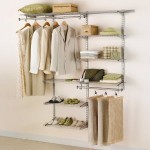
|
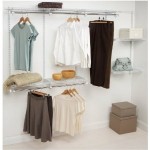
|
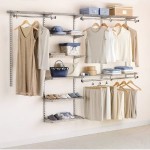
|
|
Type:
|
Starter
|
Classic
|
Deluxe
|
Classic
|
Deluxe
|
|
Size:
|
3′-6′
|
3′-6′
|
3′-6′
|
4′-8′
|
4′-8′
|
|
Shelves:
|
3 (8′)
|
5 (12′)
|
8 (18′)
|
5 (14′)
|
9 (22′)
|
|
Rods:
|
2 (5′)
|
2 (5′)
|
2 (5′)
|
2 (6′)
|
2 (6′)
|
|
Uprights:
|
4
|
4
|
4
|
5
|
5
|
|
Extensions:
|
0
|
0
|
2
|
0
|
2
|
Basically there are two sizes of kits – the 3′-6′ option and the 4′-8′ option. So measure your closet and decide which one will fit. If you have a 5′ closet say, so both kits would work, check out the specifications above with regards to the number of shelves etc, to see which one really is best for you.
To finalize your decision, you need to choose between the classic and deluxe options – the classic being the basic option, the deluxe having more shelves and 2 upright extensions allowing you to place shelves lower down toward the floor.
Tip: Sometimes you can get better value for money by buying two Classic kits rather than a Deluxe.
The kits are available in two color choices – white and titanium, which gives the kit a more polished and expensive look.
Back to top
How does the Rubbermaid closet system work?
Configurations by Rubbermaid kits are designed to maximize the space in your closet by giving you hanging space (long, short, both or double short hanging) as well as plenty of shelf space. There are also accessories, such as pants hangers or tie racks, that can be added onto any kit.
They are a complete, all in one, DIY kit aimed at beginners to do it yourself home improvement tasks. If you know one end of basic tools, such as a drill and level, from the other, then there is no need to call in a professional. You will find the whole process fun, satisfying and more importantly in this day and age, cheap.
They are made up of a horizontal rail that is secured into wall studs to provide strength and upright tracks that are hung anywhere on the rail making them versatile as they can be moved around at any time.
Look away now for the boring bit! The upright tracks are double track standards. Each shelf bracket has two sets of hooks that fit into the rows of slots in each standard. As with any standard and bracket system, the brackets are as easy to remove from the slots as they are to put in, so brackets (and therefore shelves) can be reconfigured easily.
The 3 key benefits of the system are:
- it is easy to install;
- it is fully customizable;
- it is versatile, so can be reconfigured at any time.
Check out the installation instructions below to see how easy the process is.
Now imagine customizing your own closet:
Empty your closet and install the Rubbermaid closet organization system in one of the MANY possible configurations. Choose one that suits YOUR clothes and remember you can move any or all of the components around at any time. Make the best of your closet space by using hanging rods and shelves in multiple places.


Imagine the final result but remember it would be easy to reconfigure the hanging rods and shelves by simply unlocking them from their current location and repositioning them somewhere else, such as:



And why not throw in some accessories while you’re at it!

Tip: declutter your clothes before returning them to your beautiful new closet, although this will no doubt be harder than the installation! Oh dear.
Back to top
Pros and cons of Rubbermaid closet organizers
I have crowd sourced the pros and cons of this system by trawling through over 400 reviews on Amazon and Rubbermaid’s own website and it took hours! So save yourself the trouble and check out my findings below:
THE PROS
Increase the storage capacity of closets in any room in your home
As well as your bedroom, these kits can help organize clutter in your home office, the laundry room, and many more locations. Suitable for walk in and reach in closets as well as open walls, the possibilities are endless and I bet you’ll go back for more after your first kit.

Customize and expand a basic rod and shelf layout at any time
The extras available to accessorize the basic kits, really add to the customizing possibilities. Baskets are extremely helpful to corral underwear and don’t miss the specific organizers designed for pants, ties, belts and shoes. Mix and match the huge selection of add ons on offer and own that closet – personalize it in any way you choose.
The best part is that you don’t need to buy these extras initially. Add them into your system when you’re sure you need them or your requirements change and you need that little bit of extra storage space. After your next shopping spree, buy a new basket or shelf to cope with the influx!
Your closet system is also ultimately expandable. If you have a large or L shaped closet, just buy two or more kits to make the most of your space.
If you work your way slowly through all the closets in your home, you can mix and match components between rooms to get the perfect systems in each one.
Quality but so much cheaper than other closet systems
You no longer need to look at your messy closet in despair thinking you’ll have to spend tons of money getting a custom design, the Rubbermaid kits are exceptionally good value for money typically costing between $50 and $150. As with all Rubbermaid products, they are top quality, sturdy, durable and come with a lifetime guarantee. The overall look is minimalistic but sleek and visually appealing. The polished chrome rods don’t sag and the system stays tight to the wall.
Easy to move about
Whether you are renting or likely to move house soon, or just want to move your child’s closet into a larger room, these kits are as easy to take down and reinstall in another room as they are to put up. There are not many screw holes to patch up so your closet is not locked into the one place when your circumstances change.
No need to plan for the perfect design
When trying to decide on how to design your closet, you may be stuck in ‘analysis paralysis’. How much hanging space do you need? How many shelves will work best? Long hanging or short hanging?
If you can’t decide what layout will work best for you, don’t worry. Buy the kit that will fit your closet and then experiment. Try one configuration for a week, a day or even an hour. Don’t like it? Change it. If your needs change in the future, change it.
Remove shelves to make more hanging space, add shelves for more storage. Just move shelves about. You’re the boss.
Tip: if you only store in season clothes in your closet, increase the height between shelves in the winter to store your bulky sweaters.
It’s simple – no more drilling or screwing once the initial installation is done. You just unsnap or unlock the fixings and move them about.
These kits are especially great for kids rooms as you can have hanging rods and some shelves down low for them to reach along with higher shelves out of the way. As they grow, you can move the rods and shelves up a few inches at a time.
Create more space in your bedroom
By maximizing the space in your closet, you will save space in your bedroom. This may allow you to eliminate dressers or other storage items, freeing up the bedroom to look much larger.
Clothing & user friendly
The epoxy coating on the Rubbermaid closet shelving is maintenance free. It won’t peel or chip or rust, so your clothes won’t get snagged or marked. It is durable and has a clean shiny look. There are also no jagged edges lingering about as the installation requires no cutting of shelves or any other component.
Tip: Install the shelves with their lip up to stop clothes sliding off when you remove one item.
 The easy glide hanging rod system is also heaven sent. Hangers slide easily from one end of the rod to the other – all 8′ of it if need be. The rod hangers are designed so as not to impede the track, so there is no need to remove the clothes hanger to get it from one section of the closet to the other.
The easy glide hanging rod system is also heaven sent. Hangers slide easily from one end of the rod to the other – all 8′ of it if need be. The rod hangers are designed so as not to impede the track, so there is no need to remove the clothes hanger to get it from one section of the closet to the other.
Unusually shaped closets welcome
Whatever the size and shape of your closet space, this Rubbermaid storage closet organizer will fit. No need to worry about expensive ‘custom’ work from professional installers or ‘standard’ closet organizers not fitting in without a lot of alterations, this system will fit any closet wall between 3′ and 8′ and every width in between.
DIY dummies welcome
If you know a hammer from a drill and have a bit of common sense, the easy to follow instructions will guide even the most DIY challenged amongst us to success. Most people own or can borrow the basic tools required and there is no cutting or jiggery pokery involved. The hang rails and shelves overlap and the rods are telescoping to become any size you desire. It is even possible to install on your own, although two pairs of hands would come in handy.
I hate to say this but many reviewers were women commenting that ‘even they’ managed it without any help from their husbands. Now personally I’d let my hubby get on with the drilling and screwing bit while I mulled over my layout. I’d then take over for the fun bit of putting the shelves and rods in the right places.
Speed is of the essence
There is no need to wait for weeks to get the closet of your dreams. Spend 5 minutes measuring your closet, 5 minutes ordering your kit online, OK wait a day or so for your delivery, but then a couple of hours later, it’s done. You have a new closet.
Everything you need for a complete installation is in the box. The rails, the tracks, the brackets, shelves and rods – it’s all there with the mounting hardware (screws, wall anchors etc) so there’s no need for multiple trips to the DIY store.
Most reviewers took between 1 and 3 hours to install the system. You might need extra time to remove and patch up any closet organizers you currently have installed or to paint the walls to really pimp it, but you get the basic idea – it’s a quick solution!
A place for everything and everything in its place
Rubbermaid’s closet system helps ensure you follow the above organizing mantra. Not only will your clothes have a home, where you can actually see and therefore find them, but you will have space for your shoes, purses, hats, belts and everything else that is in your closet. You really will be in closet heaven.
Add some decorative touches
The range of accessories you could incorporate into your closet organization ideas includes both wood and canvas elements to further personalize the look of your closet. For more accessories click here.


Sneaky tricks
When checking out accessories for your Configurations Rubbermaid system, you do not need to limit yourself to Rubbermaid products. Surprisingly the upright tracks for Rubbermaid, ClosetMaid and Elfa all have the same slot design, so you can interchange most accessories. You cannot interchange the upright tracks themselves as how they hang on the wall is different and you will want to consider the look of accessories made by other brands to ensure the overall theme will be maintained.
THE CONS
A review is not a review without pointing out all the bad bits as well as the good, so brace yourself. Here they are:
You may spend hours reconfiguring your closet
Being ultimately versatile is good in one way but not in another. Knowing the perfect configuration is out there somewhere may drive you (and your other half) mad. Spend some time on closet design up front to save yourself hours later on.
I don’t know anything about wall studs or drywall anchors
These two technical terms often make prospective installers a bit nervous as they are key to a securely mounted system. Don’t worry though as our ‘After sales support‘ section explains them in more detail and should put your mind at rest.
If you are not installing onto drywall (or you cannot find your wall studs) and you are not a seasoned DIYer, then you’re going to need a bit more help with working out which wall anchors to use instead.
The drywall anchors included with the kit are plastic. Now this is not necessarily a bad thing and they obviously do work. It’s just they are the weakest of all anchors, so many reviewers have purchased metal anchors or toggles which will support heavier loads. The included ones are also too shallow for 3/4″ drywall found in older houses.
Is this system for giants?
The recommended height for the hang rail is 86.5″ from the ground. Now bear in mind this is where your top shelf is going to be as well as a hanging rod. Will you be able to reach it without a step stool? Is your ceiling quite low meaning the top shelf will be useless? Do you want your lowest shelf lower than 39″ off the ground?
If so, reduce this height, say by 5″. If you prefer to leave it as it is, check out this great fold away step stool for under $15.
Be organized to save money
The cost of buying extra pieces, such as extra Rubbermaid wire shelving, to add onto your initial kit can mount up, so it is often more cost effective to buy a bigger kit than you need in the first place. If you are planning on installing this system in a few closets any leftover pieces will come in handy. Many reviewers, however, mentioned having too many pieces especially when buying the deluxe kit and then adding on accessories. So planning a great design at the outset, that has room for future expansion, is probably the best bet and will save money in the long run.
Not enough upright track
The Classic kits come with 4 or 5 upright tracks (depending on size) which is generally enough for most configurations. The problem comes if you want your design to extend further down the wall. Currently with the 47.5″ tracks, your system will only cover just over half of your wall. Now this is fine if you want to make use of double hanging space or you have shoe boxes stacked on the floor, but if you want a whole column of shelves, you need upright extenders. Two are included in the Deluxe kits or you can buy them separately, but either way you need to know this in advance to ensure you have all the pieces you need for installation.
Aaaagh there are some pieces missing
Most of the time, the kits come complete but there are occasions when pieces are missing or damaged. Before you start installing the kit, check the box against the parts list. Do not make the mistake of thinking you can call up Rubbermaid and ask them to send a replacement for the missing or damaged piece as they don’t hold such stock. They will ask you to return the WHOLE kit to the retailer for a replacement. This will cause double the frustration if you have to take down what you’ve just put up.
Aaaagh it weighs a ton
The largest kit weighs nearly 51 pounds when complete in the box. Bear this in mind if you plan on buying it at a local store or having it delivered to work. All the pieces are lightweight when dealt with individually but trying to carry that box about is not for the weedy amongst us.
Minor annoyances
The trim pieces that cover the last few inches of the hang rail can be prone to falling off.
The plastic shelf locks can break.
To ensure a good fit when overlapping shelves, one shelf is slightly deeper than the other. A few reviewers found this to look a little odd.
Back to top
Installation
Installing Rubbermaid closet storage systems is as easy as 1 .. 2 .. 3, well actually it’s 1 ..2 .. 3 .. 4, but who’s counting!
The tools you will need are: a level, a screwdriver, a pencil, a tape measure, a hammer, a drill with 1/8″ and 3/8″ bits.
Tip: Paint your closet first, then it will look much nicer and bigger once complete.
First of all you mount the horizontal hang rails. This is the most difficult bit as you need to find your wall studs to screw the rail into as well as ensure you hang it level. You don’t need to cut anything though as the two pieces of rail overlap to expand or shorten to the perfect fit. Just make sure you triple check your measurements and levels before starting!


Next you install the upright tracks. These just hang from the horizontal hang rail at the top but are screwed in once at the bottom. You start by positioning both left and right end uprights and then fill in the ones in the middle depending on the space you have and the design you want.


Tip: give your design some thought now to save time later.
The hang rail covers are used to measure the correct distance between upright tracks before being clipped into place. They will need to be 22″ apart if you will be using accessories such as drawers and sliding baskets.
 If you have bought one of the Deluxe kits, you will have upright extensions to install as well. These should be placed where you will want to install accessories or have shelving closer to the floor. There is a connector to join them to the main upright tracks as well as top and bottom screws to secure them to the wall.
If you have bought one of the Deluxe kits, you will have upright extensions to install as well. These should be placed where you will want to install accessories or have shelving closer to the floor. There is a connector to join them to the main upright tracks as well as top and bottom screws to secure them to the wall.
Step 3 is to slot the brackets into the upright tracks where desired and position the shelves.


If two shelves side by side are too long, you just need to overlap them to fit – no cutting is required. You then secure the shelves into place by sliding the plastic locking clip towards the wall until it snaps locked.


Finally fit your rod hangers to the bottom of the shelf brackets as required until they lock into place. Then place the telescoping rods into the hangers and press down to snap into place.


As you can see from the installation instructions, the rod hangers and rods as well as the shelves and brackets all slot or snap into place. This means they are easily removed and relocated to other locations within the closet system allowing for a completely customizable and reconfigurable organizer.
Back to top
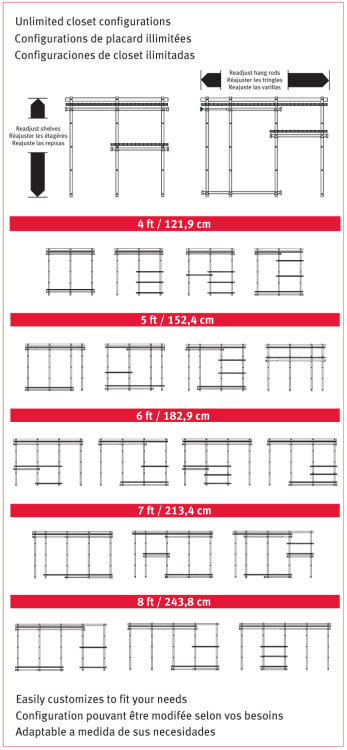 Designing your layout
Designing your layout
How to arrange the components of this organizing system is probably the hardest but most fun part of the installation. There are so many configurations you really are spoilt for choice. This is great in one way but also means you won’t really know which is best until you try it.
For some inspiration check out:
Back to top
Accessories
The range of accessories is quite vast – including extra hardware, specific organizers, canvas and wood items.
==> Click on each IMAGE for details of the full range <==
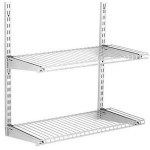
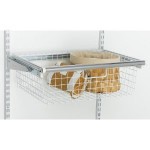
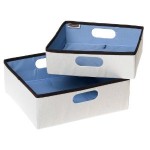
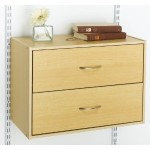
Back to top
Frequently asked questions
What comes in the box?
The closet kits are complete with everything you need for a quick and easy installation: the hang rails, the vertical tracks, brackets, shelves, hanging rods and all necessary hardware. There is no need to dash back and forth to the shop to buy individual components.
What do I need to be able to install the closet organizer?
Installation is designed to be easy although a very basic knowledge of DIY projects would help. The tools that you will require are a level, screwdriver and drill.
How are the shelves and rods installed perfectly without any need for cutting?
The rods are telescoping so can be adjusted to fit perfectly. The shelves overlap each other meaning you can overlap anything from 0″ to the whole width of a shelf to avoid having to cut them.
Do I have to follow the instructions with regards to the height of the hang rail?
No, this is your closet and the instructions just offer a guideline height that will be suitable for most people and closets. If you are shorter than average, you may want to bring the hang rail down 5″, so you can reach the hanging rods and upper shelf a bit easier.
How far apart should the vertical uprights be located?
Rubbermaid recommend that you leave 22″ of space between your uprights (inside to inside). If you want to add any accessories, this is an important consideration.
Can I buy add on brackets, shelves and hanging rods?
You cannot buy individual pieces such as hanging rods online, but you can buy add on shelving kits as part of the range of accessories. These come with four brackets and two shelves. You may be able to find more individual pieces in your local Lowes store (NB: Configurations is called HomeFree in store.)
Can I buy 90 degree corner shelves?
Unfortunately not.
Do I have to have a shelf above the hanging rod?
Yes as the rod hangers fit to the bottom of the shelf brackets.
How should I design the layout of my closet?
Rubbermaid.com as well as on the back of the box contain ideas for how you could layout the components. You could also check out our How To Organize A Closet post which has a section on how to design your closet for some useful tips. But perhaps the key thing to remember is that however you initially layout the rods and shelves, you can quickly and easily change them around if they don’t work as well as you’d like.
How easy is it to reconfigure the system once installed?
Once the hang rail and vertical tracks are installed it is very easy to move the shelves, hanging rods and accessories. They can all be moved left, right, up and down quickly and easily. Simply unlock the shelves, then unclip the brackets, move to the new location, reclip the brackets, relay the shelves and lock into place.
Can the system be expanded?
The system can be expanded by buying more vertical tracks (called Upright Extensions). These extensions can be used to extend an existing track or create a whole new one. Individual shelves can then be purchased to fix onto the track, as well as accessories such as pants organizers, baskets etc.
What are the shelf dimensions?
The basic shelf dimensions are 12″ deep, by 26″ or 48″ wide. However as the shelves overlap, you can take two shelves and create any width from 26″ to 96″, perfectly fitting your space with no cutting.
What are the hanging rod dimensions?
Due to their telescoping nature, the hanging rods can fit widths between 2′ and 8′.
What would I use the basket accessories for?
Clothing items such as underwear or accessories such as purses do not sit well on shelves so baskets are ideal to keep things together and neatly organized.
How many items can I fit on each accessory?
- The shoe rods can hold between 6 and 8 pairs of shoes. The shelves however, only hold 3-4 pairs.
- The pants organizer can hold 7 pairs of pants.
- The tie and belt rack can hold 30 items.
How should I clean the closet organizer?
The system is designed to be maintenance free but you can wipe it down with a damp cloth to keep it clean.
What is the difference between the Rubbermaid Homefree series and Rubbermaid Configurations closet system?
Nothing. Homefree is exactly the same system but it is only available in white in Lowes stores. Only the Classic kits are available; there are no Deluxe versions. You can, however, buy individual components as well as kits.
Back to top
After sales support
Full installation instructions can be found here.
I don’t know anything about wall studs
The system is designed for drywall installation with the main hang rail being fixed into wall studs. These are the vertical pieces of wood that make up the frame that holds your drywall (or plasterboard), creating your wall. Being made of wood they are a lot more secure to screw into that a thin piece of drywall and as such must be located unless you want your organizer to collapse.
They are typically placed 16″ apart but can also be found spanning 12″ or 24″. The best way to find them is using a stud finder (check out this popular one that costs about $10), although you can also try tapping lightly on the wall to find the least vibration, or drill a few holes in the drywall and find the studs by trial and error.
If your house is old or you cannot find your wall studs, you will need to secure the rail to the wall with different anchor attachments specific to your wall.
I don’t know anything about drywall anchors
The hang rail needs to be secured to the wall within 4″ from either end and at least every 24″ in the middle. For places where you do not have wall studs to screw into, you will need to use drywall anchors as fixings. These are pushed into a hole that you have drilled in the drywall until they are flush. Their strength comes from the spreading mechanism that goes on behind the drywall that stops them being pulled back through the initial hole. Screws can then be used through the anchor to hold the rail in place.
Tips:
Make sure you know what is inside or on the other side of your wall before you start your installation. You don’t want to be drilling or screwing into electric cables, plumbing pipes, mirrors etc.
To ensure you will be happy with the height of the whole system, stick a line of masking tape across the wall where you are planning to install the hang rail. This will give you a feel for whether you can reach the shelf and top hanging rod etc.
If the holes in the hang rail don’t line up properly with the wall studs, you could try drilling your own holes in the metal if you have the right drill bit or try using sturdy wall anchors, such as Hilti toggler bolts for drywall.
Don’t over tighten the screws when installing the upright tracks. A snug fit will do just fine, without breaking the drywall.
Back to top
 A closet doubler is a key closet organizer to own if you want to make use of all the available space in your closet.
A closet doubler is a key closet organizer to own if you want to make use of all the available space in your closet. 








































































 The easy glide hanging rod system is also heaven sent. Hangers slide easily from one end of the rod to the other – all 8′ of it if need be. The rod hangers are designed so as not to impede the track, so there is no need to remove the clothes hanger to get it from one section of the closet to the other.
The easy glide hanging rod system is also heaven sent. Hangers slide easily from one end of the rod to the other – all 8′ of it if need be. The rod hangers are designed so as not to impede the track, so there is no need to remove the clothes hanger to get it from one section of the closet to the other.





 If you have bought one of the Deluxe kits, you will have upright extensions to install as well. These should be placed where you will want to install accessories or have shelving closer to the floor. There is a connector to join them to the main upright tracks as well as top and bottom screws to secure them to the wall.
If you have bought one of the Deluxe kits, you will have upright extensions to install as well. These should be placed where you will want to install accessories or have shelving closer to the floor. There is a connector to join them to the main upright tracks as well as top and bottom screws to secure them to the wall. 





















 Shift your shoes into under the bed containers. Consider
Shift your shoes into under the bed containers. Consider 


 If sketching is not your thing, then various closet manufacturers such as
If sketching is not your thing, then various closet manufacturers such as 